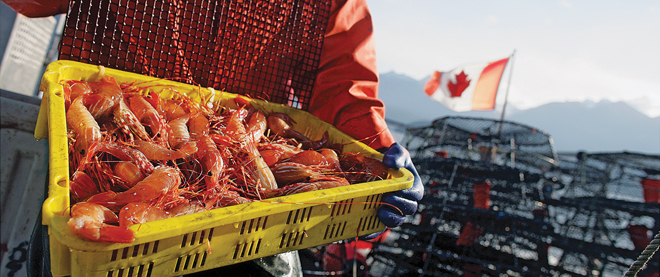The good news about B.C. prawns
‘Locally caught, no bycatch, totally sustainable.’ No wonder West Coasters are proud.
Photography by Simon Hayter; Getty Images
Share

What with the spring runoff in late May, the surface waters outside of Vancouver’s Horseshoe Bay turn distinctly brackish, a toxic mix for the spot prawns that lurk below. So, on a recent prawn hunting expedition aboard Organic Ocean One, the first stop of the crisp, spring morning was for harvesting purer seawater, sucked up from 10 m below, where it is irreproachably salty and hideously cold. “About 4? C,” explains Frank Keitsch, a cigarette dangling from his lip as he lowered the vacuum pipe into the insalubrious depths. “That’s what prawns are happy in.”
That, and hollandaise sauce, and lemon-caper aioli, and even—freshly shelled and still wriggling some—in a little ponzu, I thought to myself, waiting impatiently for the holding tanks to fill so that we could get on with things. Ducking under a low door frame adorned with a bumper sticker that reads “Friends don’t let friends eat farmed fish,” I entered the cabin to check on Steve Johansen, Keitsch’s partner in this fishing operation, and the unofficial spokesperson for the spot prawn fishery at large, who was working his cellphone.
Over his shoulder, I could see he was making last-minute adjustments to the orders on his list, which was scrawled by hand on a sheet of foolscap. It read like a who’s who of the Vancouver restaurant scene. The celebrated sushi bar Tojo’s was down for 4.5 kg of Johansen’s daily catch—same as the Blue Water Cafe, the Raincity Grill, Bishop’s and Cioppino’s. Eclipsing them all, Coast, on Alberni Street, had a request in for 18 kg. West was in for a mere two kilograms, while Robert Clark’s sustainable seafood C Restaurant had just downgraded an earlier order for 11 kg down to nine.
“About five years ago, all our spot prawns went to Japan,” Johansen began to recount, as we headed out to begin harvesting. “I had Robert Clark on my boat one day when I was prawn fishing and he said, ‘I want some of those.’ And I said, ‘You can’t have them.’ ”
Media-savvy captain Johansen has told this story often, and so it is now an extremely familiar tale: how, after that seminal conversation, Johansen and Clark started to work together to promote this great product locally, convincing chefs in Vancouver to get behind it to such an extent that the city now enjoys an annual spot prawn festival. Toronto chefs have followed suit enthusiastically; so too, now, Ottawa, and to a lesser extent, Montreal.
The driving force behind the popularity of the prawns is quality, for when eaten raw they are almost shockingly firm and sweet, a quality they maintain in spades even when lightly cooked, in which form they remind me of the finest Scottish langoustine. And then there is a backstory to the prawn that is equally compelling.
“Locally caught, no bycatch, totally sustainable,” says Johansen. And he is demonstrating his claim as he states it—for now, a mere 10 minutes out of Horseshoe Bay, Johansen and his crew are pulling in his first long line of 50 traps. Traps that rest harmlessly on the sea floor (rather than scraping it), and harm none of their bycatch, like starfish and hungry rockfish. Tipping the contents onto his sorting tray, he tosses all bycatch back overboard along with the smaller prawns (next year’s harvest), or any that are packing eggs (for eating in 2014). The ones he keeps get rinsed and stored in the seawater captured earlier, and will be on restaurant tables by evening.
It all adds up to making the B.C. sustainably fished spot prawn a product to make the locals proud. And they are—justifiably, but to a fault. You would think B.C. chefs discovered the things. Most Canadians do. But the Americans have spot prawn fisheries too—in Puget Sound and in Alaska. And theirs taste just as good as ours.
But their fishery is not as sustainably harvested as ours, because their season starts weeks earlier than ours, when the females are still full of eggs. That’s their business, I suppose. What’s mine is that Toronto fishmongers and restaurants keep selling me sustainable “B.C.” spot prawns from which eggs burst when they are cooked—which means that the only thing about the prawns that is really from B.C. is the feel-good, price-inflating advertising campaign. Watch for it at a restaurant near you.